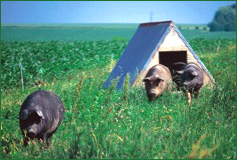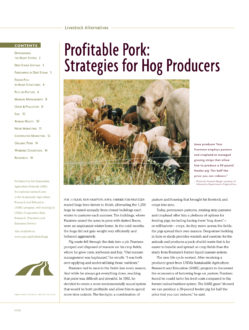
Years ago, pigs foraged in pastures, wallowed in mud to stay cool and nested in family units. Now, most pig producers raise their animals in confinement buildings containing thousands of pigs with sows in two-feet-wide crates. Lately, some farmers and consumers have begun to balk at that system.
"When the current conventional systems create profound, widespread concerns, we are compelled to look elsewhere for solutions," said Mark Honeyman, an Iowa State University researcher and national expert on alternative swine housing options. "The public's growing concern about the environment and the impact of vertical integration upon rural communities, worker health and animal welfare calls for innovative approaches and ethical judgment in the ways producers raise pigs."
Why Switch?
- Minimize environmental concerns such as water and air quality
- Improve hog worker health, which can be compromised by dust and gases in confinement buildings
- Assume less financial risk
- Create fewer objectionable odors
- Assume lower start-up costs
- Minimize neighbor problems when farming near population centers
- Manage animals rather than equipment and automated machinery
- Provide pigs with access to bedding, freedom of movement, sunshine and each other
Determining the Right Alternative Hog System
Before overhauling a hog production system, evaluate your resources, define your goals and visualize what type of operation might work best. In weighing your options, consider your buildings and what might be renovated to fit your goals, as well as your pasture or forage options.
Consider also your location and whether you have access to processing and markets. For more information about planning for a new farm enterprise, consult "Hogs Your Way." (See "Resources")
The significantly lower start-up costs for alternative swine systems may be one of the most convincing factors for producers, especially beginning farmers who may have difficulty raising capital. Other farmers adopt the systems because they allow great flexibility. Inexpensive, easy-to-build hoop structures, for example, incur no debt and are easy to adapt for other uses.
"These systems appeal to someone who doesn't want to borrow capital," said Honeyman. "If you construct a building that costs hundreds of thousands of dollars, you're going to produce, whatever happens. If you want more flexibility, you need a lower cost option. In a rapidly changing industry, why not create a system that's flexible rather than one that locks you into a certain production system?"
